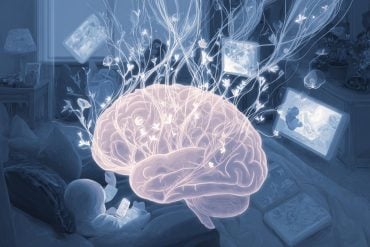Summary: A new study compared background music listening habits between young adults with and without ADHD, revealing distinct patterns in when and what they listen to. ADHD-screened participants reported more frequent music use during both less demanding tasks and while studying, with a stronger preference for stimulating tracks.
Neurotypical individuals tended toward relaxing, familiar music during cognitively heavy activities. Despite different preferences, both groups perceived similar boosts to concentration and mood from background music.
Key Facts
- Increased Use in ADHD: ADHD-screened participants used background music more often while studying and during sports than neurotypical peers.
- Stimulating Music Preference: ADHD-screened listeners favored upbeat, stimulating music across both cognitive and non-cognitive tasks.
- Shared Benefits: Both groups reported similar perceived improvements in focus and emotional well-being from music.
Why This Matters
- Why This Matters: Highlights how music can be a low-cost, customizable tool for supporting focus and mood in both neurotypical and ADHD individuals, offering potential as an accessible cognitive aid.
- How This Aligns with Previous Research: Supports theories like the Moderate Brain Arousal model and Mood Arousal Theory, reinforcing evidence that stimulation needs differ between ADHD and neurotypical populations.
- Future Implications: Could inform the creation of personalized “cognitive playlists” and targeted music-based interventions to enhance learning, work performance, and emotional regulation.
Source: Neuroscience News
Music is more than just a soundtrack to our lives—it’s a cognitive companion, an emotional regulator, and, for many, a daily necessity.
A new study comparing young adults with and without attention-deficit/hyperactivity disorder (ADHD) offers a deeper look into how background music is used during daily tasks, and why preferences may differ between these groups.
The findings reveal that while both neurotypical and ADHD-screened individuals value music’s role in focus and mood, the situations in which they use it—and the kind of music they choose—can diverge in intriguing ways.
Researchers surveyed 434 adults aged 17 to 30, dividing them into two groups: those who screened positive for ADHD and those without attentional symptoms.
Participants reported on their weekly listening time, the types of activities they paired with background music, and their preferences for music style and characteristics. They also rated music’s perceived effects on their concentration and emotional state.
Activities were split into “more cognitive” (such as studying, reading, problem-solving) and “less cognitive” (like cleaning, cooking, or exercising).
The results showed that ADHD-screened participants reported more frequent background music use during certain situations—especially while studying and exercising—and in less cognitively demanding activities overall.
They also had a stronger preference for stimulating music, regardless of the activity type. In contrast, neurotypical participants leaned more toward relaxing and familiar music during tasks requiring high concentration.
Interestingly, despite these differences in usage patterns, both groups rated music’s benefits to concentration and mood similarly, suggesting a shared appreciation for its cognitive and emotional lift.
These listening patterns fit neatly with two established psychological frameworks. The Cognitive Capacity Hypothesis proposes that our attentional resources are finite; complex tasks demand more of this “mental bandwidth,” leaving less capacity to process music.
For individuals with ADHD, whose attentional control may already be more limited, music could serve as either a helpful arousal booster or a distracting extra load, depending on the context.
Meanwhile, the Moderate Brain Arousal model offers another layer: people with ADHD may seek higher stimulation to reach optimal alertness, especially during repetitive or monotonous activities. Stimulating music, then, could be a deliberate strategy to keep focus steady.
The study also highlights the role of emotional regulation. According to the Mood Arousal Theory, music can modulate both emotional valence (pleasantness) and arousal level, influencing performance in a task-dependent manner.
Neurotypical participants’ preference for relaxing, familiar tracks during challenging activities may reflect a strategy to maintain calm focus, while ADHD-screened listeners’ attraction to stimulating, sometimes less familiar tracks could help counteract low arousal and wandering attention.
While the findings add valuable nuance to our understanding of music and attention, they also come with caveats. This was a self-report study rather than a controlled experiment, and ADHD status was determined via a screening questionnaire, not a clinical diagnosis.
Still, by capturing real-world listening habits rather than laboratory simulations, the research paints a realistic picture of how young adults integrate music into their daily cognitive routines.
The takeaway is not a universal prescription—there’s no one “right” playlist for focus—but rather an invitation to think strategically about music use.
For those with ADHD, stimulating, upbeat tracks might aid in sustaining attention for certain tasks, while neurotypical listeners may benefit from calming, instrumental choices during demanding work.
Future studies using brain imaging and controlled experiments could help clarify exactly how these choices affect neural activity, and whether personalized “cognitive playlists” could become a practical tool for enhancing focus and emotional well-being.
If the study makes one thing clear, it’s this: music isn’t just background noise—it’s an active ingredient in how we manage our minds. And the way we use it may say as much about our brains as it does about our tastes.
About this ADHD, music, and attention research news
Author: Neuroscience News Communications
Source: Neuroscience News
Contact: Neuroscience News Communications – Neuroscience News
Image: The image is credited to Neuroscience News
Original Research: Open access.
“Listening habits and subjective effects of background music in young adults with and without ADHD” by Nathalie Gosselin et al. Frontiers in Psychology
Abstract
Listening habits and subjective effects of background music in young adults with and without ADHD
Adults listen to an average of 20.7 hours of music per week, according to a study conducted across 26 countries. Numerous studies indicate that listening to music can have beneficial effects on cognitive performance and emotional well-being.
Music listening habits may vary depending on individual needs and listening contexts. However, a limited number of studies have specifically examined the patterns of background music usage during various more or less cognitive activities, especially among individuals with attentional difficulties related to ADHD.
This study primarily aimed to compare music listening habits during daily activities that are more and less cognitive (e.g., studying, problem-solving versus cleaning, engaging in sports) between neurotypical young adults and those screened for ADHD (respondents who were identified as likely having ADHD based on the number of self-reported symptoms).
To achieve this, 434 young adults aged 17 to 30 responded to an online survey.
The results indicate that certain listening habits differ significantly between the neurotypical and ADHD-screened groups.
The ADHD-screened group reports significantly more background music listening during less cognitive activities and while studying, compared to the neurotypical group.
The results also reveal a difference in the proportion of individuals preferring stimulating music between the groups: ADHD-screened individuals report significantly more frequent listening to stimulating music, regardless of the activity type (more or less cognitive). Other aspects of music listening are common to both groups.
Regardless of the group, more respondents reported preferring to listen to relaxing, instrumental, familiar and self-chosen music during more cognitive activities, whereas for less cognitive activities, more individuals mentioned preferring to listen to music that is stimulating, with lyrics, familiar and self-chosen.
Overall, the results confirm that most young adults listen to music during their daily activities and perceive positive effects from this listening.







